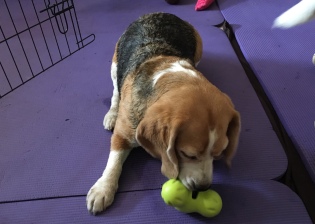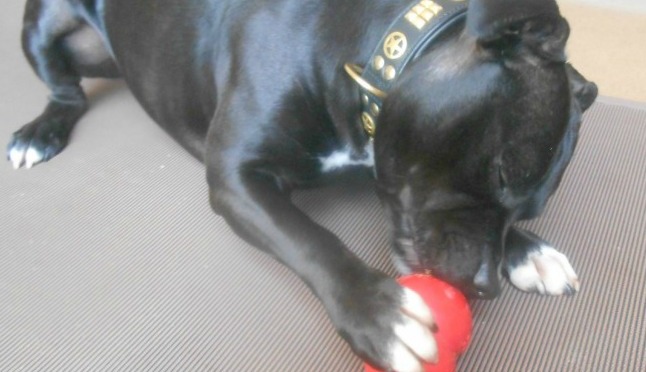What is Boredom?
Science has only recently began to look at boredom and understand what makes people bored. A 2012 review of boredom research entitled The Definition, Assessment, and Mitigation of State Boredom Within Educational Settings: A Comprehensive Review (Vogel-Walcutt, J.J., Fiorella, L., Carper, T. et al.) suggested that boredom is a combination of a subjective psychological state of dissatisfaction, frustration or disinterest and an objective lack of neurological excitement, all of which result from a lack of stimulation. (Kubota, 2016).
Do Dogs Suffer from Boredom?
Animal welfare lecturer Charlotte Burn, from the The Royal Veterinary College, observed dogs left alone at home before publishing an essay entitled Bestial boredom: a biological perspective on animal boredom and suggestions for its scientific investigation, in which she states that “Chronic inescapable boredom can be extremely aversive, and understimulation can harm neural, cognitive and behavioural flexibility.” She told The Times: “They often yawn, bark, howl and whine. Some sleep a lot – a sign of apathy. Some of this is anxiety but often they are just really bored.”
A bored dog, lacking appropriate mental and physical stimulation may get himself into trouble by looking for ways to entertain himself. “Animals in barren conditions seek even aversive stimulation, as if bored.” (Burns, 2017). Problematic behaviours such as digging, incessant barking and inappropriate destructive chewing may be a dog’s way of alleviating boredom and easing anxieties.
Provide Mental and Physical Stimulation for Your Dog
Some simple changes might go a long way in helping overcome boredom and alleviating anxiety by providing both mental and physical stimulation for the pet. Here are some suggested ‘boredom busters’:
- Make sure your dog’s diet is nutritionally balanced. A poor diet may not only affect your dog physically, it could also negatively affect their behaviour.
- Take your dog to school – Learn how to engage and motivate him!
- Provide interactive feeding and chew toys.
- Provide a doggie sandpit – an appropriate place for the dog to dig.
- Play fun games with your dog.
- Teach your dog how to relax and provide him with a comfortable place to do so.
- Vary your walking routine.
- Arrange a playdate with a suitable doggie friend.
- Arrange a Slumber Party or Sleepover for when you are away.
- Hire a certified pet care technician to spend time with your dog while you are out at work – to feed him, take him for a walk, play with him…
Interactive Feeding Toys
Whether you would like to keep your pet occupied while you are out; need your dog to be quiet while you make an important phone call; want a good way of slowing down how quickly your dog eats; want to give your dog a job in the form of an opportunity to ‘scavenge’ for his food; want to provide a suitable alternative to chewing up your furniture or nibbling on your ankles … an interactive feeding toy or appropriate chew toy is going to keep your dog busy while also providing great mental stimulation. I recommend all pet guardians provide their dog with an interactive feeding toy. My favourites are the Classic Kong, Kong Wobbler, West Paw Zogoflex Toppl or West Paw Zogoflex Tux. Nylabones are also one of my favourite recommendations for those in need of a good, long-lasting chew.
Stuffing a Kong is not only good for your dog, it is a great way of using up your surplus (doggie appropriate) groceries! One of my dogs’ favourite recipes is a mixture of cooked sweet potato and flaked chicken mixed with leftover veggies and kéfir. I simply stuff the Kong and pop in the freezer for an extra challenge!
If you and your dog are just starting out with interactive feeding toys, keep it simply by simply stuffing with some loose high-quality kibble, small chunks of meat and cheese or a few small treats. Encourage your dog to play with the toy and offer plenty of praise as he starts moving it around to get the treats out.
Another of my dogs’ favourite recipes is banana ice-cream. I blend the ingredients and pour into an ice cube tray. Once frozen, the doggie ice-cream is served in a West Paw Zogoflex Tux (the perfect size for an ice cream cube!). This is suitable for both feeding toy novices and pros.
Ingredients:
– 2 ripe bananas
– 2 cups kéfir or plain low-fat yoghourt
– 1/3 cup peanut butter (organic if you have it)
Zogoflex Tux
Put all the ingredients into a blender and blend until it’s mixed. Pour the mixture into ice trays and freeze.

One of my dogs’ and my canine clients’ much-loved low-fat alternative to banana ice cream is fish sorbet. This is how we make it:
– Three-quartersill an ice tray with water.
– Flake in some tuna, sardines, mackerel or salmon.
– Add 3 crushed blueberries or other favourite fruit such as apple, banana or melon to each cube.
– Freeze and serve in a Tux.
Here’s a final favourite recipe. This one is for a Kong ‘Summer Picnic’
Ingredients:
– 1 cup cooked ground turkey
– 1/2 cup shredded carrots
– 1/2 cup low-fat cream cheese
KONG Classic
Mix all the ingredients together in a bowl.
Split the mixture between your KONGs and freeze for a greater challenge.
You can find the above Kong ‘Summer Picnic’ and lots more stuffing recipes on the Kong website here
Please note that some food can be toxic or otherwise hazardous to dogs. No onions, sultanas, grapes, raisins, xylitol (artificial sweetener), chocolate, macadamia nuts, cooked bones. For more information on foods that could be unsafe for pets, visit the ASPCA’s People Foods to Avoid Feeding Your Pets page.
Training Classes
Attending group training classes is a great way of providing both mental and physical stimulation for your dog. If you are new to training, we advise a pet dog manners course – The DogSmith Small Paw Etiquette Puppy Class is a fantastic choice for those of you with young puppies. The Pet Dog Ambassador programme is a great choice for dogs of all ages. Fun Scent Games and Trick Classes are also highly recommended as both get a big thumbs up from dogs and guardians! If you or your dog are likely to be unhappy in a group class situation, we highly recommend private training sessions with a qualified force-free trainer.
When Should You Call a Certified Dog Behaviour Consultant?
 While implementing the above recommended ‘boredom busters’ is going to help provide mental and physical stimulation for your dog, if you have a dog with specific behavioural challenges such as: Aggression toward people; aggression toward dogs or other animals; leash reactivity and impulse control problems; excessive barking or digging; destructive behaviours; growling nipping and snapping behaviours; attachment or separation anxiety problems; shy or fearful behaviours; abnormal behaviors, such as excessive licking, air snapping or obsessive tail chasing; hyperactivity… we urge you to contact a certified dog behaviour consultant as soon as possible.
While implementing the above recommended ‘boredom busters’ is going to help provide mental and physical stimulation for your dog, if you have a dog with specific behavioural challenges such as: Aggression toward people; aggression toward dogs or other animals; leash reactivity and impulse control problems; excessive barking or digging; destructive behaviours; growling nipping and snapping behaviours; attachment or separation anxiety problems; shy or fearful behaviours; abnormal behaviors, such as excessive licking, air snapping or obsessive tail chasing; hyperactivity… we urge you to contact a certified dog behaviour consultant as soon as possible.—
More Information
The DogSmith

The DogSmith offers force-free, learning-theory based dog training programmes coupled with professional pet-sitting and dog-walking services.
Whether you’re a dog owner looking to solve a specific behavioral problem, a dog lover simply wanting to strengthen and broaden your relationship with your dog, or a family wanting the best care possible for your pets while you’re away from home, the DogSmith is the only call you’ll ever need to make.
You can locate a local DogSmith here.
The Pet Professional Guild
The Pet Professional Guild is a membership organization representing pet industry professionals who are committed to results based, science based force-free training and pet care.
You can locate a PPG Professional Member in your area by clicking here: PPG Member Search
